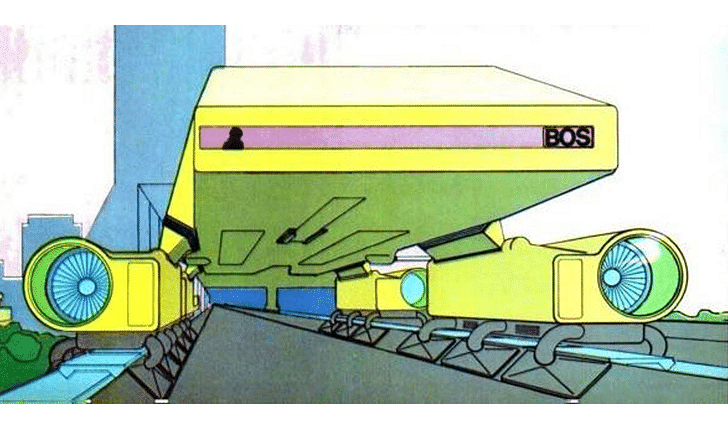

In his collected book of essays, Swimming to Utopia, Craig Hodgetts appears to be a proud writer, though his career never seems to have depended on it. Throughout the book one finds writing written purely for the thrill of it, and that is precisely why it is arguably more pleasurable than so much other architectural criticism.
Archinect Outpost is hosting Swimming to Suburbia on Saturday, March 16th, from 7-9pm. You can preorder a copy of his book here and RSVP to the event here. Craig will be speaking about the book, followed by a book signing.
It is rare these days to find a collection of critical writings on architecture that surprise the average reader of the genre. The opinions held by Jeffrey Kipnis, Ada Louise Huxtable, Sylvia Lavin and others can easily be found on bookshelves, and, with every new publication, the sharpness of their tongues can be predicted with relative accuracy over time. As these are the voices known for giving language to familiar buildings as they were first completed, it is refreshing to hear from those that happened to be there all along.
Enter Swimming to Suburbia and other Essays, by Craig Hodgetts. A collection of writing starting from as early as 1970 to the present, Swimming to Suburbia shows a rarely seen side of the architect known for his meticulously detailed buildings completed with his partner Hsinming Fung. While the work of Hodgetts + Fung may reflect the sensibilities of a team, the writing of Hodgetts alone reveal a fiercely independent voice, one that is shockingly more candid and informal than those more familiar to the genre of architectural criticism. At times deliriously poetic and other times refreshingly informal, the recently-retired UCLA professor has apparently put as much effort into his writing as he does in his structures.
While the work of Hodgetts + Fung may reflect the sensibilities of a team, the writing of Hodgetts alone reveal a fiercely independent voice, one that is shockingly more candid and informal than those more familiar to the genre of architectural criticism.
His description of John Lautner's process is a glowing example of the latter style of writing, full of imagery and inventive onomatopoeia : "The pieces of a Lautner house KA-CHUNK! together with the inevitable force a fallen tree..." And his take on Frank Gehry's house in 1978 (written one year before it was complete!) provides thoughts not expressed by more highbrow critics: "His house echoes with memorials to the American lifestyle: if one cooks in the driveway it's what used to happen on Saturdays in the summer; if the living room feels like an attic it's probably more fun to be there anyway; if the terraces end in backstops you can at least play catch..."
It appears to be a virtue that Hodgetts does not adhere to the traditions of the field. Given a generous editorial provided throughout by The Ohio State University's Todd Gannon, the reader learns that Hodgetts adopted his style of writing by refusing the titles normally attributed to people in his position: "Though the texts collected here are replete with profound insights in the nature of architecture and the working of the contemporary city, Hodgetts would resist being labeled a theorist. Nor, despite his careful presentations of the work of Stirling, the Eameses, and other key figures of twentieth century architecture, would he consider himself a historian." Gannon asserts that Hodgetts writes with such delightful idiosyncrasies because he "writes as an architect."
Hodgetts came to Los Angeles in the early 1970s and quickly found a community of names familiar today - Thom Mayne, Eric Owen Moss and Frank Gehry, to name a few. His thoughts on the various buildings he has written about come from personal connections to their architects; the writing can be seen as repeating the informal tone that he might have had while talking to their creators over drinks on the beach.
Hodgetts is clearly a proud writer, but his career never seemed to have depended on it. Throughout the book one finds writing written purely for the thrill of it, and that is precisely why it is arguably more pleasurable than so much other architectural criticism. A lot of the writing appears to have been previously unpublished, suggesting that we are newly given access into the personal inner workings of an architect with a lot on his mind and little time for formality. Hodgetts' thoughts on the gap between architecture education and practice, for instance, are entertaining given their sheer honesty ("It's those of us with a few miles on the clock who understand that a great designer brings a sensibility that transcends technical virtuosity. And the greatest gift a designer can bring to a project is humanity. And that's hard to teach. That's something you have to be").
Throughout the book one finds writing written purely for the thrill of it, and that is precisely why it is arguably more pleasurable than so much other architectural criticism.
Because so much of the writing is written with so little to prove, it stands as an endearingly personal form of architectural criticism, significantly contrasting the tones of voice we have come to expect. Imagine if, before sitting down to produce a piece of writing intended to blow the minds of its readers, we all took a deep breath and similarly reminded ourselves that writing is a way of communicating about the things that fuel our passions.
Archinect Outpost is hosting Swimming to Suburbia on Saturday, March 16th, from 7-9pm. You can preorder a copy of his book here.
No Comments
Block this user
Are you sure you want to block this user and hide all related comments throughout the site?
Archinect
This is your first comment on Archinect. Your comment will be visible once approved.